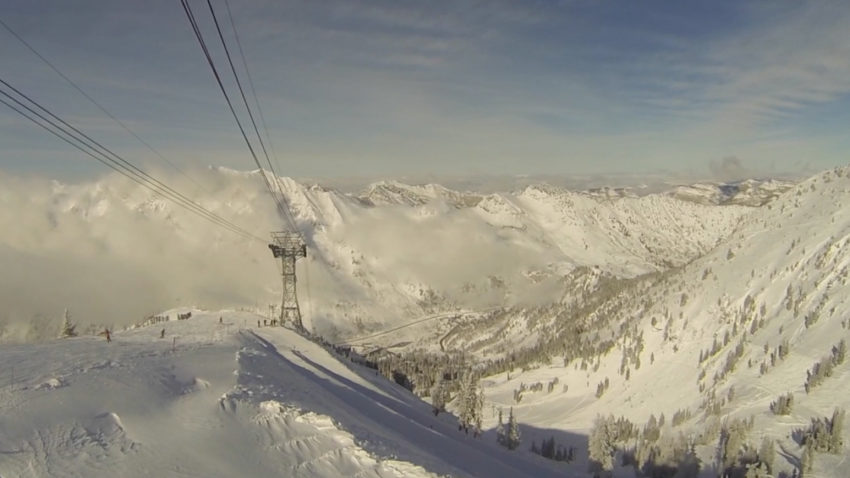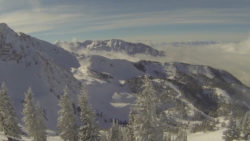Most ski resorts promote some level of environmental conservation. They typically promote the basics – water and energy conservation and climate change. But they might not be going that deep or wide with their environmental commitment. Not Snowbird. Snowbird’s commitment goes way beyond the basic talking points. For starters, they have an impressive Director of Sustainability & Water Resources, Hilary Arens. I met with Hilary Arens at the iconic Cliff Lodge at the base of Snowbird Resort in the Wasatch Mountains outside of Salt Lake City, UT to talk about Snowbird’s environmental commitment and projects.
Hilary is the point person and manager for the environmental aspects at Snowbird. She breaks down the environmental goals of Snowbird to the following.
1) Reduce the carbon footprint. This includes sustainability, using renewable energy and fuel conservation, and waste management and reduction. Ski resorts should take climate change-related issues seriously. It’s a real threat to their industry. Warm and dry is not a good mix for a winter mountain resort.
2) Improve air and water quality. If you’ve spent any time in Salt Lake City during the winter, you’re familiar with Salt Lake’s air quality concerns. Most of Snowbird’s skiers live down the canyon along the Wasatch Front and are familiar with the unhealthy inversions. The Wasatch mountains are littered with abandoned mines. One side effect of those mines is polluting water with toxic heavy metals. Snowbird is serious about protecting the upper watershed and has done some good projects to help improve water quality.
3) Engagement with the environmental community, employees, and guests. I like that the focus goes beyond engaging with the resorts guests. Connecting to the environmental community creates opportunities and becomes a valuable resource to continue their work.
Snowbird has been involved in a variety of interesting projects. I have detailed a few of them below, from cleaning up toxic mine tailings to creating a carpool app to improve air quality in the canyon. You can read more about their work and partners here.
Snowbird is at the top of Little Cottonwood Canyon. The canyon’s watershed is designated for drinking water. (Class 1C for you Utah water regulatory nerds.) That means the snow that falls on the mountain becomes drinking water. The snow you ski on today will eventually become water at your tap. It makes you think about what you might leave behind on those slopes because that snow will go from “slope to sink.”
Snowbird is also promoting Utah’s Slow the Flow program to improve water conservations. Two unique ways a ski resort can slow the flow are 1) Snowbird makes snow using surface water and 2) grooming the snow compacts the snow, which reduces the melt rate.
Pacific Mine Cleanup
Probably the most significant environmental initiative Snowbird has taken is the cleanup of the Pacific Mine tailings. Snowbird partnered with Trout Unlimited, U.S. Forest Service, and Tiffany & Co., to become the first private landowner in Utah to help fund a mining-era clean-up effort to eliminate tailings that was affecting the American Fork watershed.
Take a moment and think about that. A ski resort cleaned up the mine tailings to remove toxic cadmium, lead, and zinc from the watershed. It wasn’t the state, the EPA, or an environmental activist group. It was a ski resort. Snowbird received several rewards for this work.
This is one of those projects that may not sound as flashy as reducing climate change. But this type of project does more immediate and long term improvement on the environment than promoting carpooling.
Community Engagement and Advocacy
Snowbird has created a ride sharing app to promote carpooling to the resort – R.I.D.E. (Reducing Individual Driving for the Environment). The more you carpool, the more chances you get to earn rewards, discounted lift tickets, and a chance to ski the mountain before it opens. For those of you that don’t ski or snowboard, getting a chance to make turns on the mountain before it officially opens is a big deal, especially on a powder day.
Snowbird has a long list of partnerships and organizations. Here are a few of them.
- Snowbird is a National Ski Area Association Climate Challenge resort.
- Snowbird is a Protect Our Winters (POW) Resort Partner. POW is the leading climate advocacy group for the winter sports community.
- Snowbird became the first ski area to partner with the National Forest Foundation (NFF) in an effort to provide funds for conservation projects around the Wasatch-Cache National Forest, where the resort is located.
- They work with Cottonwood Canyons Foundation on annual invasive weed pulls and wildflower tours.
- Snowbird has partnered with Breathe Utah to educate the Snowbird community on legislative issues around air quality in Utah and provide actionable items to affect policy in the state.
- Snowbird built a seven-mile sewer system instead of using less expensive, but environmentally risky septic tanks. This is another one of those not-so-flashy projects. But infrastructure projects like this provide valuable long-term environmental improvements.
- Snowbird created its own water treatment plant, using the existing Wasatch drain tunnel. The groundwater is collected, treated, and sent down hill to your tap.
There’s so much to Snowbird’s environmental story, I didn’t capture it all here. I hope this behind the scenes look gives you a greater appreciation of the resort. Or you can just watch the above video, preferably on the biggest screen you have in order to appreciate the Wasatch mountains.
Next time you’re standing at the top of Snowbird’s tram, think about all the quality work Snowbird is doing to ensure an environmentally healthy mountain is there for you the next time you stand at the top of the mountain.


